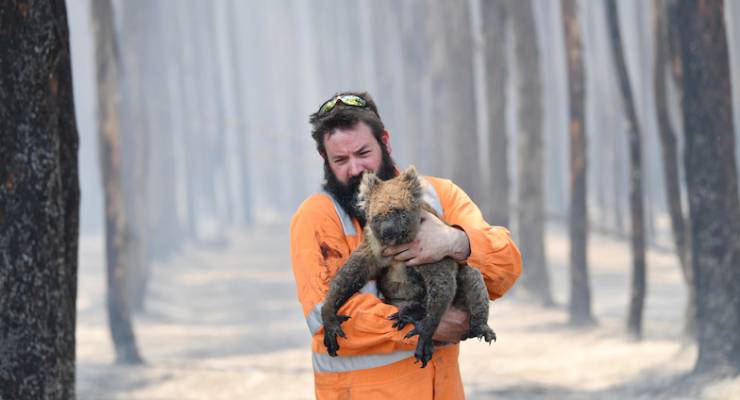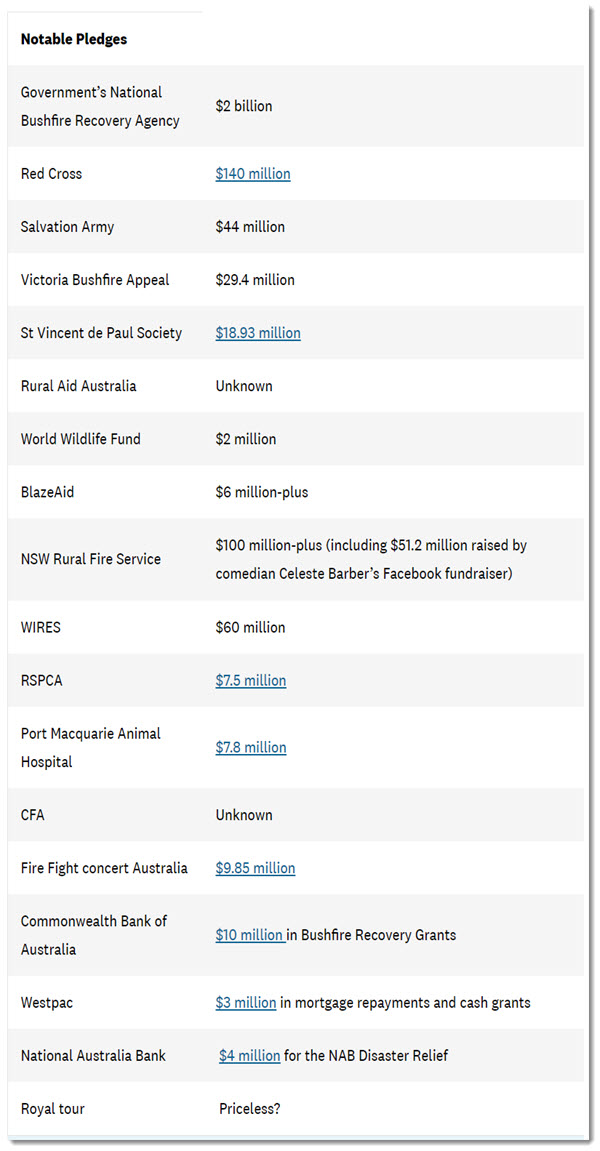
We’ve lost millions of hectares of land in the bushfires, along with dozens of lives. As Crikey calculated yesterday, the economy now faces a bill between $4 billion and $8 billion.
An eye-watering amount of donations have come pouring in from around the world — though it hasn’t come without controversy.
Crikey takes a quick look at what’s been pledged so far, and where it’s going.
The total, with some caveats in it, looks to be around $2.5 billion — $2 billion from the government, and around $450 million raised by charities alone.

Hard to boil it down
As it turns out, finding out just how much has been donated is no easy task.
While most charities update their donations periodically, there are dozens of government-endorsed charities with bushfire and relief activities and even more private Facebook fundraisers and GoFundMe pages.
Huge donations from billionaires, businesses and lobby groups are also hard to quantify. Mining magnate Gina Rinehart hasn’t released how much she has donated, or to whom, while Clive Palmer has donated use of a helicopter, pilot, and sea vessels.
Mining billionaire Andrew “Twiggy” Forrest has established his own” Fire Fund” project to “work on a long-term blueprint for fire resilience”.
But as far as we can tell, the NSW Rural Fire Service (RFS), Red Cross and different animal charities have come out on top in the donation game.
The RFS has raised over $100 million — half of which came from comedian Celeste Barber’s Facebook fundraiser, while the Red Cross has raised more than $140 million.
NSW’s Wildlife Information Rescue and Education Service (WIRES) amassed a whopping $60 million in just six weeks after images of the devastation went global.
A spokesperson for the volunteer-led team told Crikey the task of allocating the donations was a tough job — WIRES has previously only dealt with a fraction of that amount.
The RSPCA will also be getting a piece of the pie from Sydney’s Fire Fight Australia concert. The star-studded event raised $9.85 million, the profits of which will be shared between the RSPCA, the Red Cross, and rural and regional fire services.
(Organisers didn’t respond to Crikey’s questions about how much of the donations are counted as profit, or how the funds will be split.)
Despite the deluge in donations, associate professor of wildlife ecology Euan Ritchie says they won’t come close to covering what’s been lost.
“The cost is undoubtedly massive, especially when you also consider some of the ecosystem services that have been severely damaged, such as carbon storage of trees,” he told Crikey.
The government puts in its two cents
The government’s National Bushfire Recovery Agency pledged $2 billion toward relief efforts in early January — though just half of that has been allocated, a spokesperson for the agency has confirmed.
Here’s a brief breakdown of what’s going where:
- $76 million for mental health
- $60 million for local governments
- $50 million for wildlife
- $40 million for charities (primarily administered by the Salvation Army Property Trust and the St Vincent de Paul Society)
- $15 million for rural financial counsellors
- $10 million for financial counselling
- $8 million for children’s disaster payments
- $8 million for children’s mental health
- $50,000 in grants for eligible small businesses and non-profit organisations
- $5,000 in grants for primary producers.
Allocating funds is a hot topic
Few of the donations have come without controversy.
The Red Cross has been slammed for not only handing out less than a third of the $140 million raised but for also taking a 10% administration fee.
WIRES has been accused of not passing on donations to other wildlife rescue groups, while lawyers have had to get involved to figure out how to spend the $51.2 million raised by Barber for the RFS.
Donations to the RFS Trust can only be spent on firefighting equipment, and can’t be given to families or other charities.
Krystian Seibert, an industry fellow at the Centre for Social Impact at Swinburne University, says the rules are muddy around how, and how quickly, donations need to be passed along.
“Australia’s fundraising laws are state-based, rather complex and often inconsistent,” he told Crikey.
While fundraising laws require a charity to use the funds consistently with how they have said they will use them, there are no laws or caps on administration costs.
“If a charity has said that they’re fundraising for bushfire relief, then they need to use donations for that purpose. However that doesn’t mean that they have to use the funds straight away, and it can take time to properly deploy funds and ensure they are used effectively,” Seibert said.
Charities have defended their slow spending, with the Red Cross highlighting the need to have funds available for three years for when future costs — such as trauma counselling or rebuilding — kick in.








I guess if you don’t know what to do with your donations you can always blow it like this:
https://www.google.com.au/amp/s/news.sky.com/story/amp/australian-bushfires-fire-service-uses-new-york-citys-times-square-billboard-to-thank-volunteer-members-11937890
Apparently a’free use’ of the billboard was offered, but I too was scratching my head…
It’s not easy to see whether this article is a criticism of charities or not. What is Crikey’s opinion of the 10% administration fee that Red Cross will apply to the $140m?
10% costs to distribute $140m seems completely justified. Usually January is a quiet period for non-profits. Imagine suddenly receiving $140m more than was given in the same period last year. How many people would be needed to process gifts, determine appropriate grant recipients etc?
A dilemma, or if you wish a ‘wicked policy’ issue, is inherent in this donation process. Some (I have no figures) of those impacted will have made a choice to not buy insurance, despite the risk they elected to take living where they did. Do such victims warrant the same, or more, or less, donation money than their neighbours who did have insurance but were also victims? A perverse incentive may be created if this issue is not considered. Alternatively, in NZ for example, 95% of householders have earthquake insurance (earthquakes, NZs equivalent to bushfires). Should Australia move to a compulsory minimum insurance for all structures, perhaps as a component of rates or land tax?